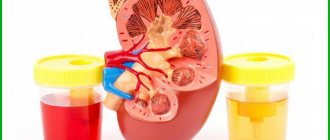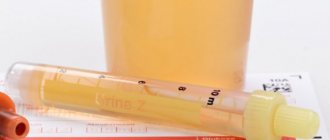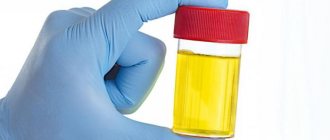Urinalysis: Frequently Asked Questions
A general urine test is a very informative and therefore common laboratory test. But the information may not be completely reliable if you ignore some rules. Tatyana Nikolaevna Yankovaya, candidate of medical sciences, gastroenterologist at the Expert Clinic Smolensk, told us how to donate urine for analysis and what indicators are important to pay attention to.
— Tatyana Nikolaevna, are clinical and general urine tests the same thing or is there a difference?
— These concepts are synonymous and denote a standard laboratory test.
— What indicators are paid attention to during a general (clinical) urine analysis? What are the characteristics of urine from a healthy person?
— First, color, transparency and the presence of sediment are assessed. In a healthy person, the urine is yellow, transparent, and there is no sediment. Acidity is another important indicator. The normal pH value is 4. Specific gravity is from 1012 to 1022 g/ml. Protein is normally absent, but trace amounts can be detected. Also, the urine should not contain glucose, bilirubin, ketone bodies and, of course, bacteria and fungi. There should be no more than 3 leukocytes in the field of view.
— What diseases can be diagnosed using a general urine test?
— Urinalysis is important for assessing the condition of the body as a whole. But for diseases of the urinary system it is of particular importance. The presence of bacteria in the urine indicates an infection in the kidneys or bladder. In case of urolithiasis, the type of stones can be determined by microscopic examination of the solid sediment.
Read materials on the topic:
A delicate problem: what you need to know about cystitis? Pyelonephritis: what is this disease and how to treat it? “This is not the time to collect stones”: what is urolithiasis?
Blood diseases also greatly change the results of a urine test. For example, during hemolytic processes, bilirubin appears in the urine.
The presence of protein in the urine usually indicates inflammatory processes. Protein also appears in the urine during injuries, intoxication, and diabetes. A sign of diabetes mellitus is the appearance of glucose and ketone bodies.
Read more about diabetes in our article
— How much urine is needed for analysis?
- 100-150 milliliters.
— Do I need a special container or is any container suitable for collecting urine?
— Due to an incorrectly selected container, the results may be distorted. If the container was not sterile, the test will show the presence of bacteria. Also, protein compounds may remain on the walls of the container, therefore, the protein test will be false positive.
Volume is also important. Therefore, it is better to give preference to special sterile containers.
— What other factors can affect the reliability of the result?
- There are many of them. Urine test results may change while taking medications. Nutrition before collecting material for analysis and external factors also influence. If a person sweats a lot due to the heat, the urine will be more concentrated and its density will increase. During intense physical activity, protein may appear in the urine of a healthy person.
The results are also distorted if the collection technique is violated.
— How to properly collect urine for analysis?
— When preparing for a urine test, it is advisable to follow a standard regimen and avoid strenuous physical exertion. A few days before the test, you need to avoid drinking alcohol and quit smoking. If you are taking any medications, tell your doctor in advance. He will decide whether it is possible to stop taking it for a while before the analysis. If not, the information will be taken into account when interpreting the results.
You need to collect urine in the morning, on an empty stomach, after a night's sleep. It is necessary to collect an average portion of urine in a sterile container. The material for analysis cannot be stored; it must be delivered to the laboratory as quickly as possible (within an hour or an hour and a half).
Perhaps you are interested in information about other tests? Read our articles in the section on laboratory diagnostics. You can sign up and take a urine test and some others here. ATTENTION: the service is not available in all cities
Interviewed by Daria Ushkova
The editors recommend:
What does a urine test according to Nechiporenko show? We detect kidney stones. CT, ultrasound or MRI - what to choose? Spring exacerbation: prevent and neutralize. Kidney and bladder diseases Does your lower back hurt? Don't panic! Laser on stones! How can lithotripsy help with urolithiasis?
For reference:
Yankovaya Tatyana Nikolaevna
She graduated from the medical faculty of the Smolensk State Medical Institute in 1993.
In 2002 she defended her Ph.D. thesis.
General practitioner, gastroenterologist at the Expert Clinic, Smolensk. Receives at the address: 8 March Street, 20.
Where can I get a clinical urine test?
Of course, a general urine test can always be performed at a local clinic using a compulsory health insurance policy. However, going to public medical institutions is not always convenient for busy, working people or for those who do not want to visit a clinic so as not to be near infected patients. In this case, the best solution would be a private medical center or laboratory, especially since a clinical urine test is usually inexpensive.
General urinalysis (UCA): norm of basic indicators, meaning
Editor: Olga Alekseeva, Curator: Elena Andreeva
Topics urine urine analysis
Why is this test prescribed?
Sometimes diseases that occur at an early stage do not yet make themselves felt. Clinical urine analysis helps to show the source of the problem and diagnose it in time. This is due to the fact that waste products are excreted along with the liquid. If the body malfunctions, then the indicators have various deviations from the norm.
Studying the physicochemical composition of urine gives a clear picture of the course of the disease. It can be classified as a general high-accuracy diagnostic test. It is prescribed in several cases:
- preventive examinations;
- pathological renal changes;
- monitoring the effectiveness of prescribed treatment;
- problems with the genitourinary system;
- monitoring of recovery over time.
The results of the general analysis provide a unique opportunity not only to timely identify the source of the problem, but also to adjust the prescribed treatment. Without them, it is difficult to diagnose inflammatory processes, diabetes, cystitis, problems with the endocrine system or gestosis.
The urinary process occurs in the kidneys from blood plasma. Urine contains more than 90% water. In addition, it includes human waste products, the composition of which can be used to judge metabolism and ongoing processes in the body. This analysis is mandatory for patients who are undergoing a diagnostic examination and have identified or suspected problems with the genitourinary, endocrine, or cardiovascular systems.
Referral for a urine test: a doctor’s whim or an effective study
Sooner or later, every person is faced with the need to undergo certain tests.
For the first time this happens in the maternity hospital. In later life, we undergo various tests if necessary. What can these manipulations give, how informative are they, and why are they even prescribed? And what does the encryption of a general urine test hide? Medicine as a science has existed for a very long time. It does not stand still and is constantly evolving. Modern laboratories are able to provide a detailed answer about the patient’s health status from a small amount of biomaterial. There are quite a few types of tests, but the most common is a general urine test. We encounter it most often throughout our lives.
Physical properties
Like any liquid, urine has its own physical properties, which also indicate the patient’s health status:
- Volume . Normally, it is up to 300 ml, regardless of gender and weight category. If this figure is below 100 ml, this indicates severe dehydration. Exceeding the norm indicates inflammatory processes.
- Color. The slightest changes in this factor are very eloquent. Normally, urine should be light yellow in color, otherwise it indicates a number of diseases. An orange-red tint indicates hepatitis or cirrhosis. A slightly reddish color also indicates critical malfunctions in the body. This can be either ordinary pyelonephritis, tuberculosis or kidney cancer. Black urine indicates alkaptonuria. If the collection gives a gray-white result, then this is a sign of purulent processes. Some medications produce OAM in a bright yellow color. That is why you should avoid them at least a day before the procedure.
- Smell . Sharp changes in aroma are characteristic of a number of diseases. For example, the smell of acetone indicates diabetes.
- Foaminess . The presence of foam during shaking indicates many deviations. This can be either stress or metabolic disorders in the body, or diabetes or cardiovascular diseases.
- Purity and transparency. Cloudy urine indicates excess salt in the human body. This may also be an indicator of mucous and purulent discharge, increased levels of red blood cells and the presence of various bacteria. Infectious diseases can also cause urine to become cloudy.
It should be remembered that the normal physical properties of urine do not indicate the complete health of the body, so you cannot rely only on these indicators. Detailed laboratory examination of the material is necessary for a complete picture and accurate results.
How to collect urine?
How to properly collect daily urine? Before taking such an examination, appropriate preparation must be carried out. The day before the expected analysis, you need to exclude alcoholic beverages from your diet, as well as fatty, spicy, and sweet foods. In addition, stop taking aspirin, diuretics, and vitamins. Daily urine should not be collected from women during menstruation; this is possible only if absolutely necessary.
For the fair half of humanity, there is an important recommendation that should be followed, namely: before urinating, you should use a hygienic sponge
Urine is collected in a special container, which can be purchased at a pharmacy. In the absence of one, it is permissible to collect it in a three-liter jar. It is recommended to buy one large container and several small containers, this will make it easier to follow the rules for collecting urine. After each urination, urine is poured from a small container into a larger one. The container must be clean, without traces of disinfectants. It should also be dry.
Before each urination, you need to toilet the external genitalia. Be sure to use soap, which is then washed off with water. Afterwards, the organs should be blotted with a clean napkin. Urine is not collected during the first urination, but the time of this act is noted. Subsequently, all urine is collected in the same container.
After each act of urination, the jar is tightly twisted and hidden in the refrigerator. The storage temperature should fit into the range from four to eight with a plus sign. Next, at the end of the collection, it is necessary to note the time at which it was completed, as well as the amount of urine. You must also stick a paper with your data on the jar, indicate the start time of collection and its end. The collected material should be shaken and about one hundred milliliters of urine should be poured into another container for general clinical analysis. After this, submit the biological material to the laboratory.
Chemical properties
When urine is delivered, it is first checked for reaction. For this purpose, universal indicators are used. Paper strips change color. To obtain the result, they are compared with a colorimetric scale.
In a normal adult diet, the reaction should be neutral. Alkaline symptoms occur in vegetarians or when taking certain medications. A bad sign is an acidic reaction. This indicates serious health problems: diabetes, urolithiasis and kidney dysfunction.
The chemical properties of urine include a number of other indicators. One of them is the density of the analyzed liquid. This indicator depends not only on the state of health, but also on the age of the patient. An important indicator that affects the density of urine is the amount of elements dissolved in it.
The progression of some diseases also causes changes in the chemical composition. A general urine test during pregnancy with an increased density of the test material indicates severe toxicosis in the patient. This condition requires immediate consultation with a gynecologist and constant monitoring by medical staff.
When conducting laboratory tests, special attention is paid to the biochemical composition of the analysis:
- protein ideally does not exceed 0.033 g/l, otherwise this may indicate dangerous diseases of the genitourinary system, heart problems, etc.;
- sugar should be no more than 0.8 mmol/l; deviations indicate possible diabetes, kidney or adrenal gland dysfunction, Cushing's syndrome. Often this indicator is increased due to a passion for sweets or during active physical activity. loads;
- bilirubin should be absent; its appearance signals the concentration of this indicator in the blood. This is a reason for a serious examination and urgent consultation with the attending physician;
- There should also be no acetone in the urine. The manifestation of ketone bodies in a urine test can be a consequence of diseases or a number of external factors: fasting, alcohol poisoning, abuse of fatty foods. A healthy lifestyle and proper nutrition can eliminate this problem.
It is worth noting that these indicators can deviate significantly from the norm during pregnancy, especially if the woman is accompanied by severe toxicosis. Therefore, there is no need to panic, you just need to consult a doctor. Perhaps he will prescribe nutritional adjustments or some dietary supplements. In some cases, hospital treatment is required.
Preparation, collection and storage rules
Like any other diagnostic examination, OAM requires certain preparation. After all, the composition of the material is influenced by many factors - both external and internal. This can be physical activity, stressful situations, various pharmaceuticals and, of course, dietary habits. To obtain correct results, strict adherence to the instructions is necessary. It is important to collect the liquid correctly:
- preparing a clean, sterile container with a tight lid - they are now sold in every pharmacy;
- the procedure is carried out in the morning, since the “night” liquid is the most informative;
- per day you cannot take medications, dietary supplements, vitamins, alcoholic beverages and products that can change the color of the biomaterial;
- fluid collection occurs on an empty stomach before eating or drinking any drinks;
- you should not overcool or overheat, so the day before the collection you should avoid going to the bathhouse, sauna or contrast shower;
- You cannot take the test during menstruation or at the stage of exacerbation of an infectious disease;
- you should wait 5–7 days if a cystoscopy was performed the day before.
Compliance with the above recommendations will allow you to get an accurate picture of the state of the body and make the right conclusion for your doctor. But how to take a general urine test? An important point remains the sterility of the container and the absence of foreign inclusions.
How to prepare? There are rules for this:
- it is necessary to take a morning shower, otherwise an increased level of red and white blood cells is very likely;
- collect an “intermediate portion” of morning urine into a clean container;
- the container should not come into contact with the skin;
- after the procedure, the container should be tightly closed with a lid;
- The shelf life of urine is no more than two hours from the moment of collection in a cool place;
- For small children, sterile urine bags are used.
Patients often have a question: how much urine is needed for a general analysis? The required volume of liquid is about 100–150 ml. This amount is quite sufficient to conduct a full diagnostic study.
What not to do when collecting urine
Collecting urine for general analysis does not accept certain actions:
- using dirty dishes, “squeezing” urine out of diapers, collecting it in a bag;
- storage for more than two hours, at temperatures above 18 degrees or in the refrigerator;
- You cannot collect biomaterial after defecation, sexual intercourse or during menstruation in women;
- it is worth refusing the analysis during acute infectious diseases of the MPS;
- You should not use a catheter unless absolutely necessary; this increases the risk of infection, especially at home.
When collecting a general urine test, it is imperative to follow the rules, otherwise there is a high risk of obtaining incorrect results. As a result, erroneous diagnosis and prescribed treatment.
Normal indicators: decoding
When receiving the results of their own tests, each person is eager to make sure that all indicators are normal. The interpretation of a general urine test can be presented in the form of the following set of data:
- straw shade;
- without flakes and cloudiness;
- with a mild odor;
- pH level 4–7;
- density in the region of 1.012–1.022;
- protein within 0.033;
- glucose level up to 0.8 mmol/l or absent;
- ketone bodies and bilirubin are normally absent;
- red blood cell results depend on the gender of the patient: in women - up to 3, in men - single indicators;
- leukocytes - up to 6 for women, up to 3 - for men;
- cylinders should ideally be absent, single hyaline values are acceptable;
- salts, bacteria and fungi should be absent.
Of course, only a competent doctor can accurately decipher the tests, but for your own peace of mind it is useful to understand the meanings of these indicators. Clinical urine analysis is very informative and provides detailed data on the condition of the genitourinary system, kidneys, and is also capable of identifying a number of different diseases in the early stages that have not yet manifested themselves symptomatically. That is why you should regularly undergo OAM for preventive purposes.
Timely diagnosis is the key to effective treatment and quick recovery without adverse reactions and complications.
And clinical analysis is the fastest and easiest way from laboratory research to obtain detailed data. Diagnostics can be carried out in any private or public clinic, as well as in stationary laboratories. The better the OAM is carried out, the more accurate the results obtained. Therefore, you should trust your health only to professionals with a good reputation.









